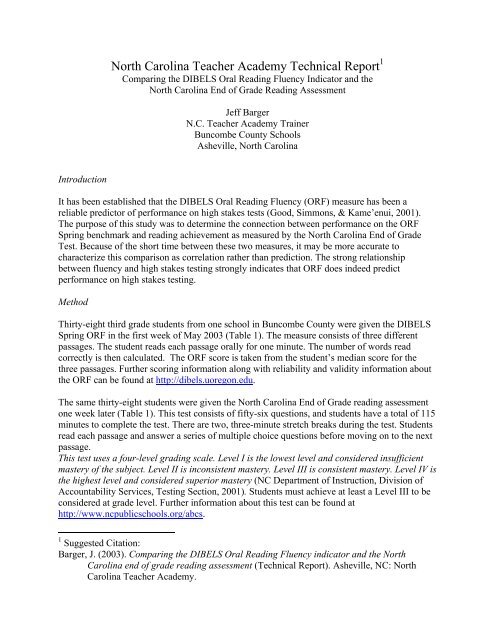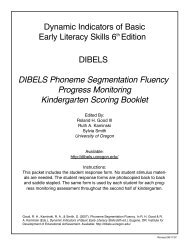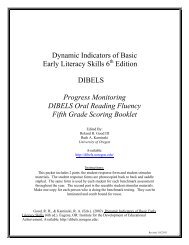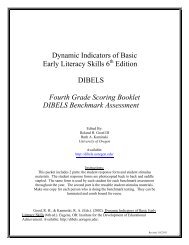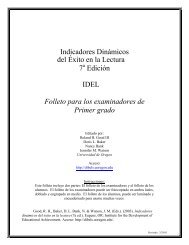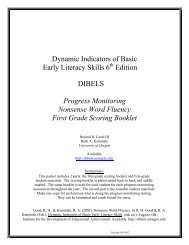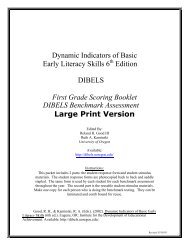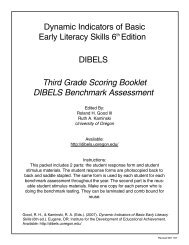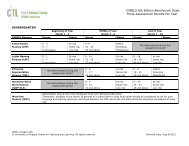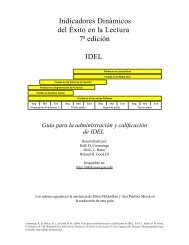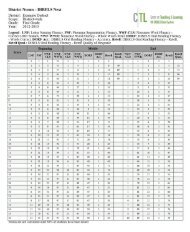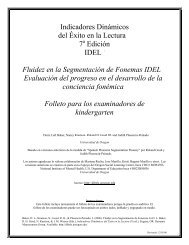North Carolina Teacher Academy Technical Report1 - Dibels
North Carolina Teacher Academy Technical Report1 - Dibels
North Carolina Teacher Academy Technical Report1 - Dibels
You also want an ePaper? Increase the reach of your titles
YUMPU automatically turns print PDFs into web optimized ePapers that Google loves.
<strong>North</strong> <strong>Carolina</strong> <strong>Teacher</strong> <strong>Academy</strong> <strong>Technical</strong> Report 1Comparing the DIBELS Oral Reading Fluency Indicator and the<strong>North</strong> <strong>Carolina</strong> End of Grade Reading AssessmentJeff BargerN.C. <strong>Teacher</strong> <strong>Academy</strong> TrainerBuncombe County SchoolsAsheville, <strong>North</strong> <strong>Carolina</strong>IntroductionIt has been established that the DIBELS Oral Reading Fluency (ORF) measure has been areliable predictor of performance on high stakes tests (Good, Simmons, & Kame’enui, 2001).The purpose of this study was to determine the connection between performance on the ORFSpring benchmark and reading achievement as measured by the <strong>North</strong> <strong>Carolina</strong> End of GradeTest. Because of the short time between these two measures, it may be more accurate tocharacterize this comparison as correlation rather than prediction. The strong relationshipbetween fluency and high stakes testing strongly indicates that ORF does indeed predictperformance on high stakes testing.MethodThirty-eight third grade students from one school in Buncombe County were given the DIBELSSpring ORF in the first week of May 2003 (Table 1). The measure consists of three differentpassages. The student reads each passage orally for one minute. The number of words readcorrectly is then calculated. The ORF score is taken from the student’s median score for thethree passages. Further scoring information along with reliability and validity information aboutthe ORF can be found at http://dibels.uoregon.edu.The same thirty-eight students were given the <strong>North</strong> <strong>Carolina</strong> End of Grade reading assessmentone week later (Table 1). This test consists of fifty-six questions, and students have a total of 115minutes to complete the test. There are two, three-minute stretch breaks during the test. Studentsread each passage and answer a series of multiple choice questions before moving on to the nextpassage.This test uses a four-level grading scale. Level I is the lowest level and considered insufficientmastery of the subject. Level II is inconsistent mastery. Level III is consistent mastery. Level IV isthe highest level and considered superior mastery (NC Department of Instruction, Division ofAccountability Services, Testing Section, 2001). Students must achieve at least a Level III to beconsidered at grade level. Further information about this test can be found athttp://www.ncpublicschools.org/abcs.1 Suggested Citation:Barger, J. (2003). Comparing the DIBELS Oral Reading Fluency indicator and the <strong>North</strong><strong>Carolina</strong> end of grade reading assessment (<strong>Technical</strong> Report). Asheville, NC: <strong>North</strong><strong>Carolina</strong> <strong>Teacher</strong> <strong>Academy</strong>.
Table 1Descriptive StatisticsGroups M SD nDIBELSOral Reading Fluency<strong>North</strong> <strong>Carolina</strong>Reading Assessment111.53 35.76 38249.18 8.78 38ResultsThe correlation between ORF Spring scores and NC End of Grade reading scores was high(r = .73). It is in line with correlations found between ORF scores and the Oregon StatewideAssessment (r = .67) by Good, Simmons, and Kame’enui (2001), and correlations found betweenORF scores and the Florida Comprehensive Assessment Reading Test (r = .73) by Buck andTorgeson (2003).Of the thirty-eight students tested, twenty-four reached the spring goal of 110 correct words perminute (cwpm) or better on the DIBELS ORF. Twenty-two of these twenty-four students alsoachieved Level IV on the <strong>North</strong> <strong>Carolina</strong> End of Grade reading test. The two students who didnot reach Level IV scored a Level III. The respective two students scored 120 and 110 cwpm onthe DIBELS assessment (Table 2).Table 2Number of students at each NC End of Grade LevelSpring ORF NC End of GradeLevel IVNC End of GradeLevel IIINC End of GradeLevel IINC End of GradeLevel I110 cwpm orabove 22 2 0 0100-109 cwpm 0 3 0 070-99 cwpm 1 2 3 045-69 cwpm 0 2 4 0
ConclusionsThis study shows the DIBELS Oral Reading Fluency measure may be an accurate predictor ofwhether or not a student will achieve a proficient score on the <strong>North</strong> <strong>Carolina</strong> End of GradeReading assessment. One hundred percent of the 26 students who scored 100 cwpm or betterachieved a passing score on the NC End of Grade assessment. Ninety-two percent of thosestudents who scored 110 cwpm were able to achieve a Level IV score. The ORF provides atarget goal (110 cwpm) for students to reach by the beginning of May.Once a student reads below 100 cwpm, the correlation between ORF and NC End of Gradescores was less clear. Only 50 percent of the students who scored 70 -99 cwpm achieved at leasta Level III on the NC End of Grade assessment.For students who scored 69 cwpm or lower, it was much more difficult to predict performancealthough it can be surmised that most students in this category are at-risk of not passing the test(Level I or II).In this study, 100 cwpm seemed to be the dividing line in terms of making an accurate predictionof whether or not a student passes the <strong>North</strong> <strong>Carolina</strong> End of Grade Reading test.ReferencesGood, R.H., Simmons, D.C., & Kame’enui, E. (2001). The importance and decision-makingutility of a continuum of fluency-based indicators of foundational reading skills for third-gradehigh-stakes outcomes. Scientific Studies of Reading, 5, 257-288.<strong>North</strong> <strong>Carolina</strong> Department of Instruction, Division of Accountability Services, Testing Section(2001). How is the information provided?Buck, J., & Torgeson, J. (2003). The relationship between performance on a measure of oralreading fluency and performance on the Florida Comprehensive Assessment Test, FloridaCenter for Reading ResearchThank you to Natalie Flindt, University of Oregon, Bob McLean and Brittany Sanders,Buncombe County Schools, and the <strong>North</strong> <strong>Carolina</strong> <strong>Teacher</strong> <strong>Academy</strong> for their assistance withthis study. Any questions regarding this report can be sent to Jeff Barger. His e-mail address isjeff.barger@bcsemail.org .


